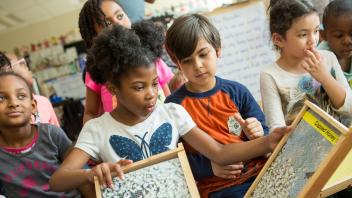Teacher question: In graduate school, we are being taught that we should use “hybrid texts” to teach content subjects. As a middle school math teacher, I think this is a horrible idea given our scant resources. Where do you stand on the use of hybrid text?
Shanahan’s response:
I share your concerns. I think hybrid text or mixed-genre text is an instructional idea that misses the point and leaves kids ill-prepared for the future.
Hybrid text is an expository text that includes narrative elements. A widely known example would be the Magic School Bus books. Those books present various social studies or science information in the context of a story.
The basic idea is to make content learning easier by presenting the information in a more friendly way. Kids are more familiar with stories than science texts, and there are lots of reasons to believe that stories are easier to understand – so embedding science content in a story should improve learning and, perhaps, would provide a more enjoyable experience (Bintz & Ciecierski, 2017).
At least, that’s the theory.
Sometimes it works and sometimes it doesn’t, but I don’t think that kind of evidence clinches the case for either side in this argument.
For example, in one study, fifth graders were found to have greater confidence with and comprehension of the content presented in narrative portions of a text versus the expository sections (Hung, 2015). Similarly, a study of middle school science found that students learned and remembered more information from texts that had embedded the key science information in the context of discovery stories (Arya & Maul, 2012).
On the other hand, a study of third and fourth graders found no differences in the ease of reading, comprehension, recall, or text preference among students presented with narrative and expository text (Cervetti, Bravo, Hiebert, Pearson, & Jaynes, 2009).
Where does that leave us?
Sometimes the use of narrative to present content information can facilitate learning.
Knowledge matters, of course, and anything that makes learning a bit easier is a good thing in my book. However, what might be slightly beneficial in the short run, may be damaging overall. There are many reasons why the use of narrative text and hybrid text to teach math, social studies, and science is not such a great idea.
One of the things that we want students to learn is how to read expository text – particularly the kinds of texts that will allow them to take on science, history, and mathematics. Research has identified several key differences in the reading of such texts and the reading of stories.
Narrative and expository texts have different purposes, structures, levels of difficulty, attractiveness to readers, dependence on prior knowledge, vocabulary, processing requirements, and so on (e.g., Best, Floyd & McNamara, 2008). Students need to learn to negotiate these varied demands.
These differences are the reason why studies show that students can be confused by the use of narrative for expository purposes (Zwaan, 1994). Students may focus on how the children in the story are going to get back from their field trip to outer space rather than on trying to distinguish comets from asteroids. If you are reading a story, it’s the characters and their intentions that matter (Ryuta & Eriko, 2006) – not the random science or social studies facts that may be salted into the story.
Good readers align their reading purposes with the genre they are reading. Hybrid texts tend to confuse this issue – adding an additional processing tier for good readers (“this isn’t really a story, so I need to ignore the story elements here”) while confusing less sophisticated readers (“I worked hard at understanding that story and the teacher didn’t ask me any questions that were relevant to what I read”).
Another problem with this approach is that it misleads students into not studying hard enough. Readers estimate how well they understand a text and increase or reduce effort accordingly. If I think the text is easy, I reduce my effort. Studies show that students are misled by the narrative characteristics of these texts, reducing their effort because they misjudge how well they are doing (Golke, Hagen, & Wittwer, 2019).
My advice? If you want to teach students to read math text, don’t seek a storybook that embeds mathematical facts or operations into a provocative narrative.
Students will learn to read math by reading authentic math text with guidance and instruction from someone who knows how to read such text.
Reading some other kind of text might make it easier, but that won’t help students to prepare for a life of reading the kinds of texts necessary to succeed in STEM fields. And, that is especially important for girls and minorities who tend to end up excluded from these opportunities.
Learners benefit from clear models. Hybrids just confuse the matter.
References
Arya, D. J., & Maul, A. (2012). The role of the scientific discovery narrative in middle school science education: An experimental study. Journal of Educational Psychology, 104(4), 1022-1032. doi:http://dx.doi.org.proxy.cc.uic.edu/10.1037/a0028108
Best, R.M., Floyd, R.G., & McNamara, D.S. (2008). Differentiated competencies contributing to children’s comprehension of narratives and expository texts. Reading Psychology, 29, 137-164.
Bintz, W. P., & Ciecierski, L. M. (2017). Hybrid text: An engaging genre to teach content area material across the curriculum. Reading Teacher, 71(1), 61-69. doi:http://dx.doi.org.proxy.cc.uic.edu/10.1002/trtr.1560
Cervetti, G. N., Bravo, M. A., Hiebert, E. H., Pearson, P. D., & Jaynes, C. A. (2009). Text genre and science content: Ease of reading, comprehension, and reader preference. Reading Psychology, 30(6), 487-511. doi:http://dx.doi.org.proxy.cc.uic.edu/10.1080/02702710902733550
Golke, S., Hagen, R., & Wittwer, J. (2019). Lost in narrative? the effect of informative narratives on text comprehension and metacomprehension accuracy. Learning and Instruction, 60, 1-19. doi:http://dx.doi.org.proxy.cc.uic.edu/10.1016/j.learninstruc.2018.11.003
Hung, Y. (2015). Taiwanese grade-five students reading a chinese science text of mixed sub-genres: A miscue analysis study. Journal of Curriculum and Teaching, 4(1), 30-41. Retrieved from http://proxy.cc.uic.edu/login?url=https://www-proquestcom.proxy.cc.uic.edu/docview/2009555431?accountid=14552
Ryuta, I., & Eriko, K. (2006). How do situation models differ in narrative and expository text? A comparison based on five situational dimensions. Japanese Journal of Educational Psychology, 54(4), 464-475.
doi:http://dx.doi.org.proxy.cc.uic.edu/10.5926/jjep1953.54.4_464
Zwaan, R. A. (1994). Effect of genre expectations on text comprehension. Journal of Experimental Psychology: Learning, Memory, and Cognition, 20(4), 920-933. doi:http://dx.doi.org.proxy.cc.uic.edu/10.1037
About the Author
Literacy expert Timothy Shanahan shares best practices for teaching reading and writing. Dr. Shanahan is an internationally recognized professor of urban education and reading researcher who has extensive experience with children in inner-city schools and children with special needs. All posts are reprinted with permission from Shanahan on Literacy .

